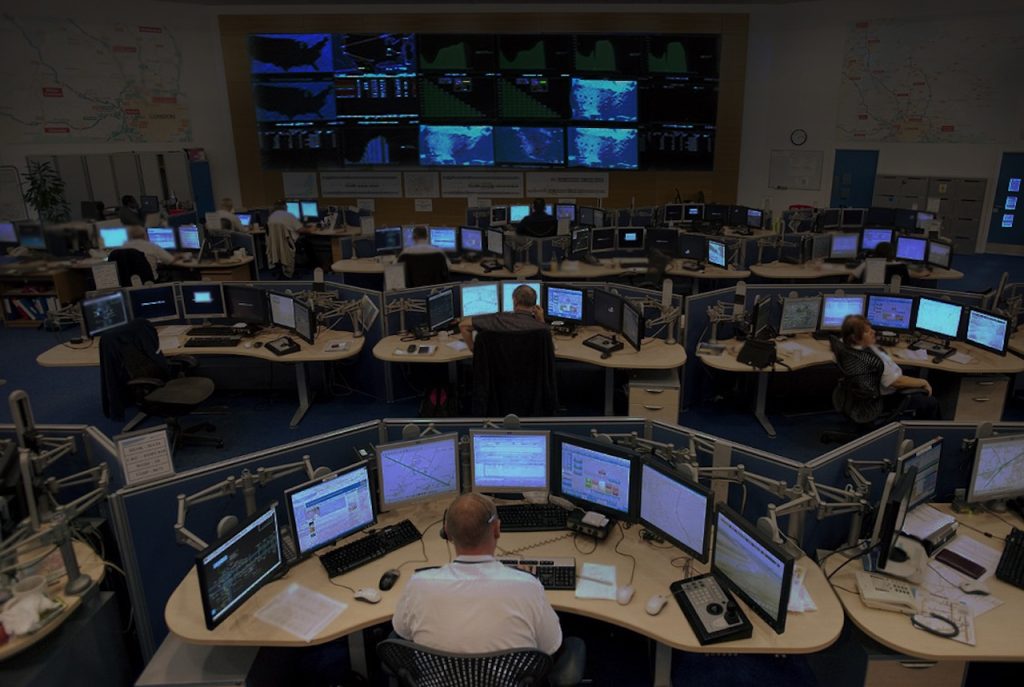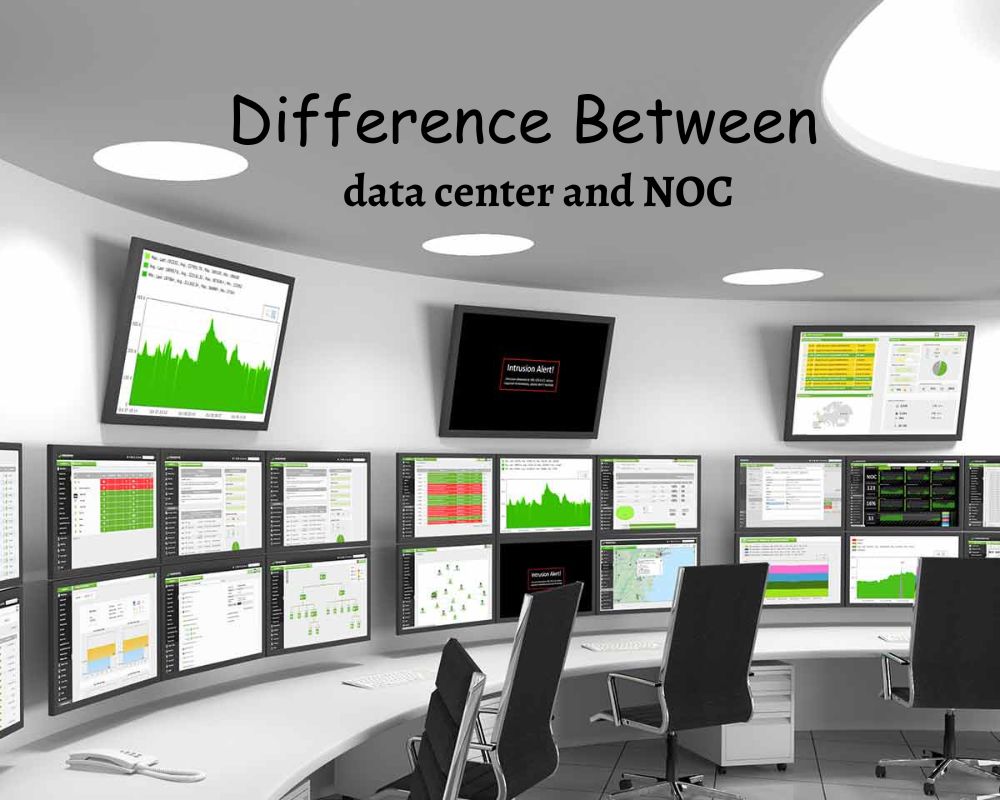data center and NOC: The computer industry is not complete without a data center or NOC. The data center stores telecommunication and server components. The data center is also responsible for controlling services such as air conditioning, system security, and fire suppression. NOC stands for Network Operations Center. It is where networks are managed and controlled. NOC monitors networks like computers, television, and telecommunication to ensure smooth operations. Data centers are primarily responsible for housing the necessary equipment to operate the network, and ensuring its security. NOC’s main role is to ensure that the network equipment is working properly and correct any faults in the event of a breakdown.
Definition of a data center

Its Data centers are physical locations that house multiple computers, network equipment, storage systems, and other essential components necessary for processing, storing, and managing digital data. Their primary function is creating an ideal environment to ensure smooth computing and data resource availability and efficiency.
To ensure the smooth functioning of data centers, they are equipped with multiple components including server racks and cooling systems as well as security and fire suppression systems. Finally, trained personnel manage the maintenance, security, and overall operation of each data center.
Data centers serve many functions. Their main role is storing, processing, and retrieving large volumes of data while guaranteeing high availability and reliability for digital services and apps hosted there. Many organizations – businesses, governments, educational institutions, and service providers alike – utilize these centers for hosting websites, managing data, running applications, or providing cloud computing.
Definition of a Network Operations Center (NOC)

Network Operations Centers (NOCs) are centralized facilities or command centers designed to monitor, manage and preserve the integrity and performance of computer networks or telecom infrastructures. As the hub of network operations, a NOC provides real-time analysis and support services for various network infrastructures and services.
NOCs are comprised of network technicians and engineers who perform various duties related to network operation. A NOC typically fulfills these roles:
- Network Operations Center (NOC) Monitoring: To ensure optimal network operation, the NOC uses software and monitoring tools to continuously monitor all network components such as routers, switches, servers firewalls, and other devices. They monitor performance while identifying any issues within networks.
- The NOC Team is responsible for incident management: When network issues or outages arise, they act quickly to identify their causes and assess any impacts before taking necessary actions to rectify them. They adhere to established incident management procedures for reduced downtime and prompt service restoration.
- Performance Optimization: The NOC’s primary duty is to optimize network performance and meet service level agreements. This involves analyzing network traffic patterns, capacity planning, and implementing performance-enhancing measures as well as making recommendations regarding upgrades or improvements for their network.
- NOC Change Management: NOC is responsible for overseeing changes to networks, including configuration updates, software upgrades, and any hardware purchases or additions. Change management policies are implemented to minimize disruption and ensure documentation and communication of any modifications or updates to networks.
- Teamwork and Collaboration: NOC teams collaborate closely with IT departments, service providers, and other stakeholders to resolve network issues and coordinate activities efficiently. In order to address concerns effectively they often collaborate with customer support teams, network architects, and system administrators as well as external vendors.
NOCs play an indispensable role in maintaining network availability, reliability, and performance. A NOC’s main functions include smooth operations of the network; reduced downtime; and providing an exceptional user experience by actively monitoring incidents that arise and responding accordingly.
Importance of data centers and NOCs in modern technology infrastructure
Modern technology infrastructure cannot exist without data centers and Network Operations Centers – these centers serve many important purposes for their infrastructures and users alike. These reasons make data centers and NOCs essential components.
- Data Access and Storage: Data centers offer the infrastructure and resources necessary to safely store large volumes of digital information. By ensuring the availability, redundancy, and accessibility of their storage solutions, they enable organizations to access critical information at any time – something essential for companies, governments, and any other entity relying heavily on data-intensive operations.
- Reliable IT Operations: Data centers house all the equipment and hardware required for mission-critical websites and applications, including power backup, cooling systems and security features that ensure continuous operation. Furthermore, their dedicated buildings minimize service disruptions or downtime risks.
- Flexible and Scalable Infrastructure: Data centers offer flexible yet scalable infrastructures, enabling organizations to expand their computing resources and storage capacities as their needs increase. Data centers’ flexibility also enables them to accommodate any increases in network traffic or any reduction of servers – plus provide additional storage capacity when necessary. Scalability is particularly useful for companies experiencing seasonal fluctuations or growth spurts.
- NOCs are responsible for managing and overseeing network infrastructure: By monitoring traffic, devices, and performance metrics continuously, they ensure the availability, security, and performance of the network. When problems arise in their network they act quickly to fix them quickly while minimizing downtime while optimizing performance for seamless connectivity.
- Incident Response and Troubleshooting: NoCs are responsible for incident response and problem-solving when network outages or problems occur, employing technicians that can quickly detect and address network issues to minimize business impact and restore service efficiently through following incident management procedures and employing diagnostic tools.
- Optimizing and Enhancing Performance: NOCs are responsible for optimizing and enhancing network performance, planning capacity, and meeting service level agreements. They analyze traffic patterns on the network to detect bottlenecks or recommend upgrades or modifications; this enables organizations to optimize network performance while meeting rising user demands.
- Collaboration and Coordination: Data centers and NOCs work collaboratively with service providers and other stakeholders. Coordination between efforts is essential to ensure smooth operations, resolve issues quickly, and communicate effectively – it fosters problem-solving efforts while strengthening security measures and network management capabilities.
Data centers and NOCs have become essential elements of modern infrastructure. Serving as the cornerstone for data management and storage as well as network reliability, performance, and security; data centers and NOCs allow organizations to provide IT services with confidence while meeting ever-evolving digital demands.
Data Center Overview

Data centers are facilities designed to manage and house critical computing resources such as servers, network equipment, storage systems, and other components that enable digital data to be stored, processed, and retrieved from memory storage systems. A data center serves as the focal point for data management and distribution for an organization or multiple clients in case it’s a cloud or colocation-based data center.
This provides an introduction to key features of a Data Center:
Data centers are designed as secure environments for data storage, processing, and management. Their controlled environment provides high levels of availability, reliability, and access to computing and data resources.
- Infrastructure: To enable the smooth operation of data centers, they require various components and systems including, Rack-mounted and blade servers that perform data processing, host applications, and perform other necessary functions.
- Here is an overview of networking equipment:
- Storage systems: Disk arrays and tape libraries are devices designed to safely store and retrieve information. Air conditioning systems and cooling mechanisms that maintain ideal humidity and temperature levels.
- Power Supply: Backup generators and Uninterruptible Power Supply Systems (UPS).
- Physical security: Access control systems, cameras, and biometric identification are employed to prevent unauthorized entry into the data center. Other measures also help provide protection from unwanted entry.
- Fire Suppression Systems: Systems designed to detect and suppress fires to mitigate risks and avoid incidents.
- Environmental Monitoring: These systems and sensors monitor temperature, humidity and other variables which could impede equipment performance.
- Connectivity: Data centers typically connect to external networks like the Internet, private networks and telecommunication providers in order to transfer and access their resources.
- Redundancy and high availability: Data centers employ redundancy measures in order to prevent service interruptions from power outages or equipment failure. This may include multiple cooling and power systems, multiple connections to their network, and backup systems ensuring operations continue despite power or equipment issues.
- Standards and Compliance: Many data centers follow recognized compliance frameworks such as ISO 27001 or Tier Standards set by the Uptime Institute to ensure reliability. Compliance refers to the process of making sure a data center conforms to recognized standards in security, reliability, and efficiency.
Organizations that rely on massive data storage and processing rely heavily on data centers as they form the backbone of essential IT operations, hosting applications and services as well as providing essential digital infrastructure support necessary for modern businesses, government agencies, and organizations to operate efficiently in today’s data-driven society.
Network Operations Center (NOC) Overview

A Network Operations Center (NOC) is the central facility that monitors, manages, and maintains computer and telecom infrastructures. As the hub of all network operations, its role is essential in guaranteeing performance, reliability, and optimal operation of networks.
This document presents an introduction to a Network Operations Center (NOC):
- Purpose: A NOC serves to manage and oversee network infrastructure to maintain performance, reliability, and availability. As the center for network control, its primary responsibility lies with diagnosing and solving network problems.
- Monitoring and Alerting: The NOC continually monitors its network infrastructure including routers and switches, firewalls, servers and VPN gateways using network monitoring software and tools. They track network traffic metrics to detect anomalies or potential problems with traffic flows or metrics as well as generate alerts when an issue arises or thresholds are breached allowing further investigation to take place.
- Incident Management: As soon as network issues or outages arise, the NOC initiates incident management. Their teams follow predefined processes to identify the root cause, assess its impact and prioritize accordingly based on severity. They work quickly with relevant teams and service providers in order to minimize downtime as soon as possible.
- Troubleshooting and Diagnostics: NOC staff are experienced in troubleshooting network issues using various diagnostic tools. NOC teams employ log analysis and packet capture techniques as well as tests conducted against network monitoring data in order to troubleshoot issues quickly and diagnose them accurately. NOC teams take an organized approach when solving problems using their knowledge to collaborate with vendors or other teams as necessary.
- Performance Optimization: NOCs strive to optimize network performance in order to meet service level agreements (SLAs) and deliver an enjoyable user experience. They do this by analyzing traffic patterns and metrics such as bandwidth consumption, latency, or other indicators to identify areas of potential improvement – with results including traffic shaping or optimization measures taken as appropriate.
- Change Management: NOCs oversee the implementation of network changes by adhering to all change management procedures and working in coordination with system administrators, network engineers, and other teams to execute changes such as software upgrades or hardware installation. It is the responsibility of NOC to make sure that changes are thoroughly tested, documented, and communicated before being made in order to avoid unintended effects and minimize disruptions.
- Collaboration and Communication: NOCs work closely with IT teams and other stakeholders, communicating network updates, incidents, and progress in resolution to all relevant parties such as network architects, external vendors, customer support teams, and system administrators system NOCs are essential resources for solving network issues quickly and enabling effective communication across teams.
NOCs play an indispensable role in maintaining the availability, performance, and security of networks. A NOC helps ensure smooth network operation while minimizing downtime – giving users and customers who rely on network services an excellent experience by monitoring, managing, and optimizing infrastructure.
Key Differences between the data center and NOC
NCs differ dramatically. Here are the main distinctions:
Focus and Scope of Data Centers:
- Data centers serve to house and manage physical infrastructure such as servers, storage devices, and networking devices in an orderly and controlled environment for data storage, retrieval, and processing.
- NOCs provide network infrastructure monitoring and management. Their primary task is identifying network issues while also optimizing performance for optimal use of resources.
Infrastructure:
- Datacenter: These centers house servers, storage systems, and other components needed for data storage and processing, giving priority to factors like cooling systems, electricity supply, and physical security.
- NOCs (Network Operations Centers): NOCs specialize in monitoring networking devices like routers, switches, and firewalls to monitor network connectivity, performance, and traffic management. Their infrastructure allows them to oversee these essential processes effectively.
Functionality:
- Data Centers: A data center is a physical location that provides resources and an environment conducive to data processing and storage. Furthermore, data centers ensure its security, accessibility, and availability.
- NOC (Network Operations Center): A NOC monitors and manages network infrastructure to ensure maximum performance and availability, with special attention paid to network monitoring, troubleshooting, and optimization activities.
Staff and expertise:
- For an optimal data center environment, personnel experienced in data storage, hardware administration, server administration, and maintenance of physical infrastructure must be present.
- Personnel with expertise in network monitoring, troubleshooting, and network administration will be needed for NoC operations.
Goals and Objectives of Data Centers:
- Data centers aim to ensure data is stored safely and accessibly while remaining accessible and reliable for maintenance. Their primary focuses are security, accessibility and availability – three primary considerations when creating or operating one.
- NOCs serve a range of objectives including network availability, performance optimization, managing incidents effectively and overseeing smooth operations of network infrastructure.
Collaboration:
- Although two distinct entities, data centers, and NOCs work collaboratively. Data centers provide the infrastructure and connectivity required by NOCs while NOCs manage network connectivity of servers, equipment, and infrastructure located within data centers.
- NOCs specialize in monitoring and management of network infrastructure while data centers focus on physical facilities for data storage. Both components form integral parts of modern technology infrastructures; effective collaboration between NOCs and data centers is vital to ensure smooth operations and optimal performance.
Collaboration between Data Centers and NOCs
Communication among Data Centers, Network Operations Centers (NOCs), and IT Infrastructure is crucial in order to preserve its performance, security, and availability.
Here are the main elements of collaboration among them:
- Infrastructure Integration: NOCs and data centers work hand in hand to seamlessly incorporate their network infrastructure with that of their data center environment. It is crucial to coordinate the positioning and connection of network equipment like switches, routers, and firewalls within this environment.
- Monitoring and Alerting: The NOC has access to data centers equipped with monitoring tools that collect important infrastructure performance metrics, which allow it to track network connectivity, server health issues, and bandwidth consumption among other metrics relevant to networks.
- Incident Management: The NOC works collaboratively with data center staff to address problems when network outages or issues occur. NOC staff share alerts and diagnoses with their colleagues at the data center so that they may address infrastructure-related issues more efficiently.
- Change Management: NOC and data center teams work collaboratively during network upgrades or modifications, sharing any planned modifications with their data centers to ensure any impacts to physical infrastructure are properly considered.
- Security Measures: Data Centers and NOCs collaborate in providing security solutions for both physical and network infrastructures. Data centers may implement physical security systems like surveillance or access control upon receiving alerts from NOC regarding network vulnerabilities or security events.
- Troubleshooting and Problem Resolution: NOC teams and data centers work collaboratively when network problems arise, sharing information, conducting joint diagnostics, and applying their expertise to determine their root causes and implement solutions.
- Communication and Reporting: To facilitate information flow between the data center team and NOC teams, effective channels must be set up for exchanging updates on information status or incident reports as well as meetings to review performance or incidents to address potential problems proactively. Meetings or reviews ensure these efforts take place regularly to maximize the effectiveness of both teams working together in this regard.
Data centers and NOCs that promote collaboration can ensure smooth operations, maximize network performance and quickly address any problems. By working together they ensure availability, reliability, and security in IT infrastructure.
Conclusion
In short Data centers and NOCs are distinct entities within the IT landscape, each performing specific functions essential for the organization’s success. While data centers are focused on managing and storing data and NOCs are responsible for connectivity to networks and perform. By recognizing their differences and working together effectively, companies can make use of the strengths that both data centers as well as NOCs to build the most efficient IT infrastructure.

